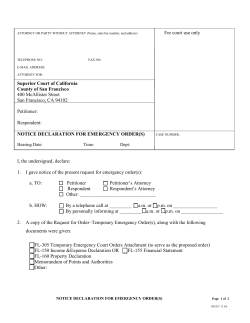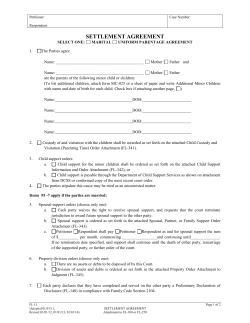
Company Law Update - The Chamber of Tax Consultants
CORPORATE LAWS – Company Law Update -DQDN&3DQG\D&RPSDQ\6HFUHWDU\ CORPORATE LAWS Company Law Update [2015] 188 Comp Cas 485 (CLB) 2. Respondent No. 1 is a Company where as respondent Nos. 2 to 4 are the shareholders and directors of the Company. 3. Respondent no 4 holds around 37.39% of the shareholding of the company. She resigned as director of the Company. 4. The two directors of the company as per MCA websites were related to respondents holding shares of the company. [Before the Company Law Board – Mumbai Bench] Ms. Varshaben S. Trivedi vs. Shree Sadguru Switch Gears P. Ltd and Others. The act of oppression may be fully permissible under the law as legal, however, when said action is against the probity, good conduct, burdensome, harsh and is mala fide or for a collateral purpose, then it would amount to oppression under section 397 of the Companies Act, 1956. Brief Facts The Petitioner has refiled this petition under sections 397 and 398 read with section 402 of the Companies Act, 1956 (“Act”). The said petition is for certain acts of oppression and mismanagement purportedly committed by respondents. The said petition was originally heard and decided by the CLB member at that time and had granted certain reliefs. The petitioner being aggrieved had filed petition before the Hon. High Court Gujarat. The Hon. High Court has set aside the judgment and directed the CLB to hear the case afresh. The facts as submitted in the original petition are as follows. 1. Petitioner holds around 62.36% equity shares of the Company. ¯162 The allegations made by the petitioner are as follows: 1. The appointment of respondent Nos. 2 and 3 as directors were illegally made and without her knowledge. As she was one of the two directors of the board. No notice was received by her for proposed board meeting, where the two directors were appointed. It was submitted that form 32 filed with RoC mentioned the board resolution is “00” thus, it shows that no board meeting was held and the director who has ſled has no authority. 2. The director can be appointed by the shareholders in Extra Ordinary General Meeting (“EGM”) only and board of director has limited powers for the appointment of an additional director or alternate director. | The Chamber's Journal | 0DUFK | 0/ CORPORATE LAWS – Company Law Update 3. Registered Ofſce of the Company has been shifted by illegally constituted board of directors. Petitioner has not received any notice for such board meeting. 4. Petitioner was illegally removed as a director under section 284 of the Act in the alleged EGM. Further, no board meeting was held before holding EGM, which is must. The petitioner has not received any notice for said board meeting or EGM. 5. The funds of the Company were siphoned by the respondent No. 2 and 3 for their personal beneſt. The following relief has been sought in the petition. 1. That petitioner be restored as a director of the Company. 2. The two respondent directors should vacate the office as their appointment is null and void. 3. The petitioner is allowed to appoint additional director form the quorum for a board meeting. 4. The two respondent directors should repay back the siphoned fund. 5. All actions taken by the two respondents directors should be declare as null and void. From respondent sides, the above allegations were refuted. They have provided the evidence by of Certificate of Posting for sending notice for calling EGM under section 169 of the Act. They have also claimed that since the petitioner has failed to call EGM as requisitioned, they have called the EGM as provided in said section 169. Judgments and Reasoning 1. The CLB has set aside the appointment of two respondent directors. ML-375 The CLB has reviewed the various decided case on oppression and mismanagement. The judgments in the case of Needle Industries (India) Ltd. vs. Needle Industries Nerwey (India) Holding Ltd. [1981] 51 Comp Cas 743 (SC); 1981 3 SCC 333 ; M. S Madhusoodhanan vs. Kerala Kaumudi P. Ltd [2003] 117 Comp Cas 19 (SC); [2009] 1 SCC 212; Dale and Carrington Invt. P. Ltd v. P.K. Prathapan [2004] 122 Comp Cas 161 (SC); [2005] 1 SCC 212; Sangramsinh P. Gaekwad vs. Shantadevi P. Gaekwad [2005] 123 Comp Cas 566 (SC); [2005] 11 SCC 314 to decide. a. Where the conduct is harsh, burdensome and wrong. b. Conduct is mala fide and is for collateral purpose. c. Action is against probity and good conduct. d. Even though the action is legally permissible, if same is otherwise against probity, good conduct or is burdensome, harsh or wrong. The CLB has relied on various decisions on delivery of notice through “certiſcate of posting” including Supreme Court Judgment in the case of M. S Madhusoodhanan vs. Kerala Kaumudi P. Ltd. where it was observed that the …”evidence by certiſcate of posting was not reliable when relationship between the parties is already embittered…”. Further, in case of Dankha Devi Agarwal. Tara Properties P. Ltd [2006] 133 Comp Cas 236 (SC) it was held by Supreme Court that …. a decision taken in a meeting without due notice of such meeting for removal or induction would be instance of oppression and mis-management.” The decision in Zora Singh vs. Amrik Singh Hayer [2009] 149 Comp Cas 328 (P&H), it | The Chamber's Journal | 0DUFK| 163 ¯ CORPORATE LAWS – Company Law Update was held that. ”when the receipt of all the notices were denied by the respondent, the mere production of such certiſcates do not satisfy the requirement of law.” 2. 3. 4. 5. CLB has also set aside the resolution for shifting of registered ofſce. CLB has noted that upon contention of respondents and analysis of facts and documents, same are not to be relied upon. On removal of petitioner under section 284 of the Act, CLB has set aside the decision taken in EGM and declared the same is also set aside. The CLB has verified both sides of argument including that same is very much applied to even a private company. However, CLB has accepted the contention of a petitioner as to illegal removal without any valid reason. CLB accepted that when company is not working for last so many years and that company has surrendered its tax registration certificate thus there was no logic for respondent to remove her as a director which it is nothing but gaining control over the company. CLB has relied upon the judgment in V. G. Balasundaram vs. New Theatres Carnatic Talkies P. Ltd. [1993] 77 Comp Cas 324 (Mad.) On Siphoning of fund, CLB has noted that as per respondents, the said amount was paid to certain creditors, which were not paid by petitioner, while she was running the company. CLB has directed that Board should get the accounts audited and decided upon such allegation. CLB has also rejected other contention respondents as to illegal allotment of shares by petitioner earlier and that petitioner has not come with clear hand. Further, respondent claimed that petitioner has not ſled any submission for winding up of the company etc., both the above pleas were rejected. ¯164 [2015] 188 Comp Cas 1 (SC) [In the Supreme Court of India] I.P. Holding Asia Singapore P. Ltd and Another vs. Securities and Exchange Board of India. The perception of the risk and threat in the business is to be decided from the perspective of the acquirer and same cannot be decided on the basis of the hindsight of the SEBI. Brief Facts This application is made by the appellants against the order of the Securities Appellate Tribunal (“SAT”) at Mumbai. As per SAT order, the appellants were directed to pay a non-compete fee to the public shareholders of the target company as paid to outgoing promoters. The appellant No. 1 is a Singapore based company. Appellant No. 2 is its India based subsidiary. The appellants had agreed to purchase shares from the out-going promoters (“Bangur Grup”) of Andhra Pradesh Paper Mills Ltd. (“Co.” or “Target Co.”). The appellants had entered into two agreements with the Bangur Group to acquire their 53.46% shareholding in the company at a price of ` 523/- per share. The appellant also agreed to pay additional ` 21.20 per share as exclusivity fee. Thus, total amount to be paid was ` 544.20 per share. Appellant also entered into a non-compete and business waiver agreement for which they have paid additional amount to Bangur Group. As per the Regulation 10 of the SEBI (Substantial Acquisitions of Shares and Takeovers) Regulations, 1997 (“Code”), appellant have an open offer to remaining shareholders of the Co. to acquire up to 21.54% equity shares at a price of ` 544.20/- per share. On open offer letter, SEBI has made an observation to offer a share price of ` 674.93 by adding the non-compete fee paid to Bangur Group. | The Chamber's Journal | 0DUFK | 0/ CORPORATE LAWS – Company Law Update The contention of the SEBI is that out of total number of members of Bangur Group consisting of companies and individuals, only some of the promoters entities were eligible for non-compete fee. With regards to 13 promoter entities, as per SEBI, none of them are eligible for non-compete fee payment as they were not in the business of Target Co. Being aggrieved with the SEBI’s contention, the appellants had ſled application with SAT. The SAT also agreed to the SEBI’s contention. of offer price, then the jurisdiction of SAT is triggered. In the present situation, the fee is less than 25% and thus, SAT has no jurisdiction. Court has noted the decision in G.L. Sultania vs. Securities and Exchange Board of India [2007] 137 Comp Cas 658 (SC); [2007] 5 SCC 133. In this it was noted that “for the acquirer the decision to acquire shares is a commercial decision.” 2. On the non -payment to one of the individual, after going through his degree, his working with Target Co. and his holding indirect shareholding in another promoter entities, Court has opined that it is odd that SEBI and SAT concluded that he did not have sufſcient information, access or ability to be in a position to compete with the Target Co. business. 3. Court has also observed that other individuals have the master degree in business administration and also a director of the company and thus can not be said that she lacked experience to offer any competition. 4. The perception of the appellants as to risk and threat from such promoters’ entities. From their perspective, such individual holding directly or indirectly shares in the Target Co. and having business experience and same can not be decided on the basis of the hindsight of the SEBI. 5. Second error on splitting the payment of non-compete fees to only certain promoter entities and excluding other entities is an error on the part of SAT. If the noncompete fee is a sham, then the entire agreement would have to be held as a sham and not only a part of it being treated as sham. SAT view is that payment of non-compete fee is a sham to deprive the other shareholders their rightful claim, SAT decision was based on the followings: 1. 2. 3. SAT relied on its earlier three appeals, that it had jurisdiction to decide on whether an excessive amount of non-compete fee paid to promoter entities and that some of them were not capable to compete with business of the Target Co. Two individuals not having any experience or expertise in such business were paid such fee only because they are part of promoter’s entities. For other 13 non-individual promoters’ entities, SAT has observed that none of them are in the business of the Target Co. and thus, cannot offer any competition to its business. Judgments and reasoning The Supreme Court has upheld the appeal. The following were the points considered by the Court. 1. As per Regulation 20(8) of takeover code, for non-compete fee, if exceeds above 25% ML-377 | The Chamber's Journal | 0DUFK| 165 ¯
© Copyright 2025









